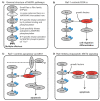The secret life of kinases: functions beyond catalysis
- PMID: 22035226
- PMCID: PMC3215182
- DOI: 10.1186/1478-811X-9-23
The secret life of kinases: functions beyond catalysis
Abstract
Protein phosphorylation participates in the regulation of all fundamental biological processes, and protein kinases have been intensively studied. However, while the focus was on catalytic activities, accumulating evidence suggests that non-catalytic properties of protein kinases are essential, and in some cases even sufficient for their functions. These non-catalytic functions include the scaffolding of protein complexes, the competition for protein interactions, allosteric effects on other enzymes, subcellular targeting, and DNA binding. This rich repertoire often is used to coordinate phosphorylation events and enhance the specificity of substrate phosphorylation, but also can adopt functions that do not rely on kinase activity. Here, we discuss such kinase independent functions of protein and lipid kinases focussing on kinases that play a role in the regulation of cell proliferation, differentiation, apoptosis, and motility.
Figures







References
-
- Manning G, Plowman GD, Hunter T, Sudarsanam S. Evolution of protein kinase signaling from yeast to man. Trends in biochemical sciences. 2002;27:514–520. - PubMed
-
- Manning G. The Protein Kinase Complement of the Human Genome. Science (New York, NY) 2002;298:1912–1934. - PubMed
-
- Deshmukh K, Anamika K, Srinivasan N. Evolution of domain combinations in protein kinases and its implications for functional diversity. Progress in biophysics and molecular biology. 2010;102:1–15. - PubMed
-
- Krebs EG, Fischer EH. The phosphorylase b to a converting enzyme of rabbit skeletal muscle. Biochim Biophys Acta. 1956;20:150–157. - PubMed
-
- Krebs EG, Kent AB, Fischer EH. The muscle phosphorylase b kinase reaction. The Journal of biological chemistry. 1958;231:73–83. - PubMed
LinkOut - more resources
Full Text Sources
Other Literature Sources

